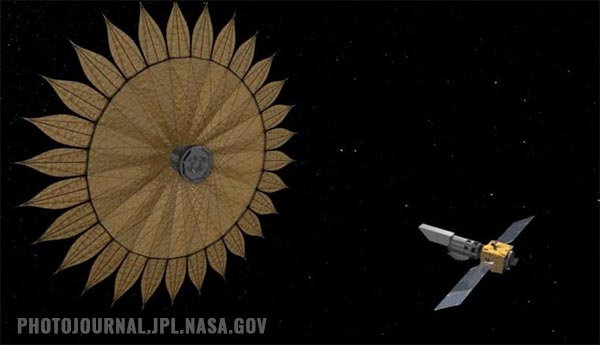
Advertisement
NASA has announced its plans to use “starshade” technology on exoplanet-hunting missions. Recent research from the space agency suggests that while the plans may be technologically daunting, it’s not impossible and well within NASA’s reach.
Astronomers all over the world have been detecting exoplanets for over a decade now. However, their work has been done only indirectly. Taking a proper picture of an exoplanet is difficult because of the dim light that it emanates. This already dim light is further blinded by the light from its star, which is burning billions of times brighter. NASA’s starshade technology could theoretically block out the starlight while preserving what little light the exoplanet already emanates. This technique is called starlight suppression.
The mission to launch a starshade would involve using a space telescope and a separate spacecraft flying 25,000 miles ahead of the telescope. This craft would be equipped with a large, flat disc in the shape of a flower with petals around the edges. This is the starshade, and its job is to make sure the telescope can capture an image of the exoplanet without the glare from the nearby star destroying the quality of the image. (Related: It took 10 years to prove: First exoplanet finally confirmed.)
Light suppression as a way of capturing clear photographs
The flower-shaped petals of the starshade are integral to the effectiveness of the technology. According to Dr. Stuart Shaklan, engineer at NASA’s Jet Propulsion Laboratory (JPL), and lead engineer on the starshade project, “The shape of the petals when seen from far away creates a softer edge that causes less bending of light waves. Less light bending means that the starshade shadow is very dark, so the telescope can take images of the planets without being overwhelmed by starlight.”
As soon as the starshade blocks out the light from the nearby star, the light coming from the exoplanets orbiting the star should be visible enough to capture in clearer photographs. However, NASA’s JPL has a long way to go before they can deploy the starshade, as Shaklan and his team have several obstacles they still need to overcome, such as how to position the starshade precisely in space to ensure that it can be deployed accurately. Furthermore, they must also figure out a way to unfurl the starshade so that all the “petals” end up at the right position. Shaklan and his team need their measurements to be accurate that if the “petals” were to be just two millimeters off, the starshade may not work effectively.
Luckily, several other members of Shaklan’s team are hard at work creating a computer program that can detect alignment failures through a camera placed inside the space telescope. The starshade isn’t made to block out all light, and it would form a light-and-dark pattern that the camera can recognize and remember. If any misalignment were to occur, the camera would be able to recognize it thanks to the computer program.
Despite this and many other hurdles Shaklan’s team has to go through, many exoplanet hunters are excited by the potential of starshade technology. “One of the starshade’s strengths is simplicity,” said Jeremy Kasdin, principal investigator of the starshade project. His team is creating a scale model of the starshade to verify if it can block light in the way JPL’s computer simulations have predicted. “Light from the star never reaches the telescope because it’s block by the starshade, which allows the telescope system to be simpler.”
Sources include:
Advertisement
Advertisements
















